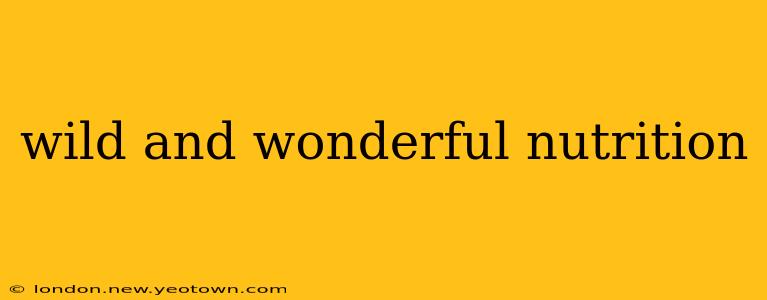The world is brimming with incredible, nutrient-rich foods, many of which we overlook in our modern, processed-food-centric lives. Imagine a diet bursting with vibrant colors, diverse flavors, and the pure energy of nature – that's the essence of "wild and wonderful nutrition." It's about reconnecting with the power of whole foods, embracing seasonal ingredients, and discovering the incredible health benefits found in nature's pantry. This isn't just a diet; it's a journey back to the roots of healthy eating, a celebration of flavor and vitality.
Let's embark on this adventure together, exploring the wonders of wild and wonderful nutrition.
What are some examples of wild foods?
Wild foods encompass a vast array of edible plants, fungi, and even insects found in natural environments. Think juicy wild berries bursting with antioxidants, earthy mushrooms packed with vitamins, and protein-rich insects that are increasingly recognized as a sustainable food source. Foraging for these wild edibles is a rewarding experience, connecting you directly with the land and its bounty. However, it's crucial to exercise caution and only consume plants you can confidently identify as safe and edible. Misidentification can lead to serious consequences, so it’s always recommended to learn from experienced foragers or take a guided foraging tour. Some common examples include:
- Wild Berries: Blackberries, raspberries, blueberries – these offer potent antioxidant benefits.
- Mushrooms: Chanterelles, morels, and oyster mushrooms – diverse in flavor and nutritional content. (Note: Proper identification is critical before consuming any wild mushrooms.)
- Edible Greens: Dandelions, nettles, and lamb's quarters – surprisingly nutritious and versatile in cooking.
- Wild Herbs: Yarrow, chamomile, and St. John's Wort – offering medicinal properties as well as flavor.
What are the benefits of eating wild foods?
The benefits of incorporating wild foods into your diet extend far beyond simple nutrition. They offer a unique combination of advantages:
- Nutrient Density: Wild plants often boast higher concentrations of vitamins, minerals, and antioxidants than their cultivated counterparts. This is due to their adaptation to diverse environmental conditions and the absence of chemical fertilizers and pesticides.
- Biodiversity: A diet rich in wild foods promotes gut health and overall well-being by introducing a wider range of beneficial compounds and microbes.
- Sustainability: Harvesting wild foods sustainably supports biodiversity and reduces our reliance on intensive agriculture.
- Flavor & Excitement: Wild foods bring a unique zest and intrigue to your culinary experiences. Each season unveils new flavors and textures to savor.
Are wild foods safe to eat?
This is a crucial question. While many wild foods are perfectly safe and delicious, it's essential to prioritize safety. Never consume a plant unless you are absolutely certain of its identity. This means:
- Learning from Experts: Take a guided foraging walk or attend workshops led by experienced foragers.
- Using Reliable Identification Resources: Consult reputable field guides and online resources with caution.
- Starting Slowly: Begin by consuming small quantities of a new wild food to assess any potential allergic reactions.
- Avoiding Contaminated Areas: Avoid harvesting plants near roadsides, industrial areas, or places where pesticides or herbicides might have been used.
How can I incorporate more wild foods into my diet?
Integrating wild foods into your diet doesn't require a complete overhaul. Start small and gradually expand your repertoire:
- Foraging (with caution): Learn to identify common, safe wild edibles in your area.
- Shopping Local: Support local farmers markets and producers who offer wild-harvested or sustainably grown produce.
- Experimenting in the Kitchen: Explore recipes that incorporate wild foods, adding them to salads, soups, or as side dishes.
What are the potential risks of eating wild foods?
While the benefits are plentiful, it's important to acknowledge potential risks:
- Misidentification: The most significant risk is consuming a toxic plant. Always be absolutely certain of a plant's identity before consuming it.
- Allergies: Some people may be allergic to specific wild foods. Start with small quantities to check for any adverse reactions.
- Contamination: Wild foods can be contaminated with bacteria, parasites, or pesticides if harvested from unsafe locations.
Embarking on a journey of "wild and wonderful nutrition" is an exciting exploration of flavor, health, and connection with nature. By exercising caution and learning from experienced guides, you can unlock the incredible nutritional benefits and culinary delights that the wild has to offer. Remember, safety and proper identification are paramount. Enjoy the adventure!

